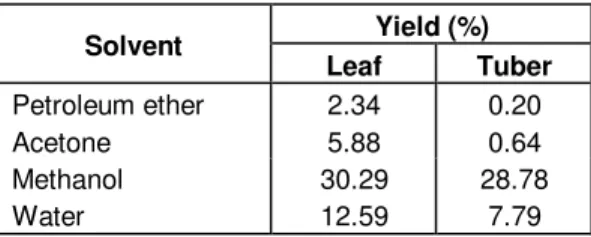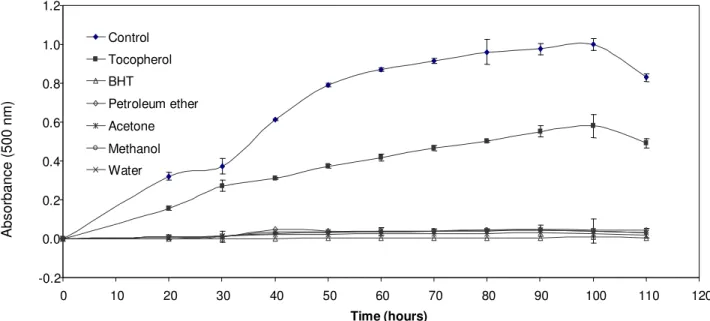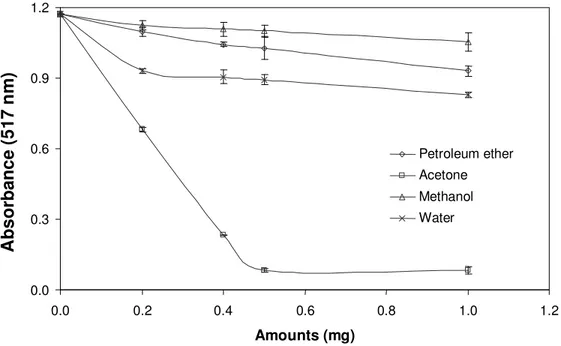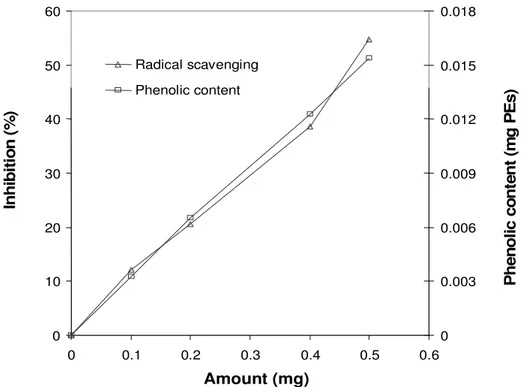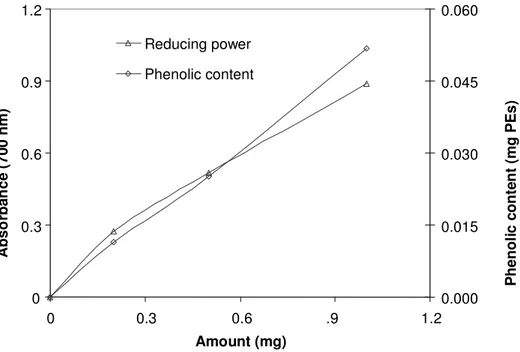Full Length Research Paper
Antioxidant activities of solvent extracts from endemic
Cyclamen mirabile Hildebr. tubers and leaves
Cengiz Sarikurkcu
Department of Chemistry, Faculty of Science, Mugla University, 48170 Mugla, Turkey. E-mail: sarikurkcucengiz@yahoo.com. Tel: + 90-505-645 30 51.
Accepted 7 January, 2011
In this study, solvent extracts were prepared from different parts of Cyclamen mirabile (CM) and their antioxidant activities were evaluated. Other antioxidant properties of all extracts of CM tubers and leaves, including free radical scavenging activity, reducing power and total phenolic compound content, were also determined. Leaves extracts of CM exhibited higher antioxidant activity than tuber extracts with all the types of solvent used. All concentrations of petroleum ether, acetone, methanol and water extracts of CM leaves showed higher antioxidant activities than that of 0.5 mg of α-tocopherol (42%) and close to BHT (99.30%) and had 96.60, 96.00, 96.10 and 97.40% inhibition of lipid peroxidation of linoleic acid at same doses, respectively. All extracts of CM tubers and leaves had effective free radical scavenging and reducing power. In addition, total phenolic compounds in all the extracts of CM tubers and leaves were determined as pyrocatechol equivalents.
Key words: Cyclamen mirabile, antioxidant activity, reducing power, scavenging activity, total phenolic
compound.
INTRODUCTION
One of the principal causes of food quality deterioration is the oxidation of unsaturated lipids initiated by free radicals. When lipids are exposed to environmental fac-tors such as air, light and temperature, oxidation reac-tions start to produce undesirable flavours, rancid odours, discoloration and other forms of spoilage. The primary autoxidation products are hydroperoxides, that have no taste and flavour, but their degradation products (alde-hydes, ketone, etc.) have very potent taste and flavour modifiers (Gordon, 1991).
Reactive oxygen species (ROS), such as hydroxyl radical, hydrogen peroxide and superoxide anions, are produced as by products in aerobic organisms and have been implicated in the pathology of a vast variety of human diseases including cancer, atherosclerosis, dia-betic mellitus, hypertension, AIDS and aging (Halliwell and Gutteridge, 1984; Wallace, 1999; Lee et al., 2000a). Therefore, antioxidant activity is an important in-view of the free radical theory of aging and associated diseases.
To retard or prevent the oxidative deterioration, the antioxidants are added in food. The added antioxidants then maintain the quality and extend the shelf-life of
many food products (Andreja et al., 2000). The anti-oxidants can be of synthetic or natural origin. The use of synthetic antioxidants is restricted in several countries, because of their possible undesirable effects on human health (Branen, 1975; Chen et al., 1992; Kahl and Kappus, 1993). Hence, the studies on natural antioxidant have gained increasingly greater importance.
In the search for sources of natural antioxidants, in the last few years some medicinal plants have been exten-sively studied for their antioxidant activity and radical scavenging activity (De las Heras et al., 1998; Desmarchelier et al., 2000; Schinella et al., 2002; VanderJagt et al., 2002). A number of studies on the antioxidant activities of various aromatic plants have been reported over the last 20 years (Brraco et al., 1981; Herrmann et al., 1981; Kramer, 1985; Lagouri et al., 1993). Flavonoids and other phenolic compounds of plant origin have been reported as scavenger of ROS, thus, they are viewed as promising therapeutic drugs for free
radical pathologies (Parshad et al., 1998; Lee et al., 2000b). The antioxidant activity of plant origin is dependent on the type and polarity of the extracting solvent as well as
on the test system and the substrate to be protected by the antioxidant (Heinonen et al., 1998; Moure et al., 2000; Kang and Lee, 2001). Solvent extraction is frequently used for isolation of the antioxidants and both extraction yield and antioxidant activity of the extracts are strongly dependent on the solvent, due to the different antioxidant potentials of compounds with different polarity. For these reasons, comparative studies for selecting the optimal solvent providing maximum antioxidant activity are required for each substrate. Although, the use of different polarity substances can provide more exhaustive infor-mation on the properties of the extracts, literature con-tains few reports of the polarity-based solvent extraction of medicinal plants (Kang et al., 2003).
Cyclamen mirabile Hildebr, is an endemic species
grown in South-west Anatolia (C2 Mugla, C3 Isparta), Turkey, where it grows in Pinus brutia forests and hill slo-pes with maquis, on limestone, metamorphic and granitic rocks, at altitudes of 400 to 1600 m and flowers from September to November (Davis, 1978).
The tubers of C. mirabile contain glycosides such as starch, glue, organic acids and saponins. In addition, it has emetic purgative and stimulant effects. The infusions that are made by fresh tubers cause medium intensity diarrhea. The overdoses that are the medical dosage cause dangerous toxication which appears with vomit and strong diarrhea. The tubers are eaten usually by pigs (Baytop, 1984). Calis et al. (1997) had previously repor-ted the study of the triterpenoid saponins of C. mirabile Hildebr. This resulted in the isolation of six saponins and their biological activities (antibacterial and antifungal). There are no sufficient studies on C. mirabile. Addi-tionally, systemic and multi - method evaluations on anti-oxidant activities of solvent extracts of this species has not previously been reported. Therefore, the data presented here will be the first record on C. mirabile.
The purpose of this study was to evaluate the anti-oxidant activity of various solvent extracts from different parts (tuber and leaves) of C. mirabile using petroleum ether, acetone, methanol and water. Other antioxidant properties of all solvent extracts, including scavenging activity on 1,1- diphenyl - 2 - picrylhydrazyl, reducing power and total phenolic content were also determined.
MATERIALS AND METHODS Plant materials
Different parts (leaves and tubers) of C. mirabile were collected from the natural environment of Mugla city in Turkey in October 2002 and cleaned to remove any residual compost. The air-dried leaves and tubers were ground to fine powder and then, stored in an air-tight container until further use.
Chemicals
Ammonium thiocyanate, ascorbic acid, potassium ferricyanide,
ferrous chloride, ferric chloride, Folin-Ciocalteu’s reagent (FCR), polyoxyethylenesorbitan monolaurate (Tween-20), methanol, ethyl acetate and trichloracetic acid (TCA) were obtained from E. Merck (Darmstadt, Germany). 1,1-diphenyl-2-picrylhydrazyl (DPPH), butylated hydroxytoluene (BHT) and α-tocopherol were obtained from Sigma Chemical Co. (St. Lois, MO). All other chemicals and solvents were of analytical grade.
Extraction
10 g of air-dried parts of C. mirabile were extracted with four different solvents (petroleum ether, acetone, methanol and water). 10 g of powdered of C. mirabile leaves and tubers were extracted in soxhlet apparatus with 100 ml of petroleum ether until the extraction solvent became colourless. 10 g of powdered C. mirabile leaves and tubers were extracted with 200 ml of acetone and methanol solvents in a shaking incubator at 25 ± 1°C for 24 h. The extraction was repeated twice at same condition. These extracts were filtered and the organic solvents were removed in vacuum by a rotary eva-porator (Heidolph Laborota 4010, Germany). For water extraction, 10 g of powdered of C. mirabile leaves and tubers was mixed with boiling water (500 ml) for 15 min. The extract was filtered and evaporated in vacuum below 70°C on a rotary evaporator (Duh and Yen, 1997).
Determination of antioxidant activity
The antioxidant activities of extracts from different parts (tubers and leaves) of C. mirabile were determined by the thiocyanate method (Mitsuda et al., 1996). 1 ml of extracts at different concentrations were mixed with 2.5 ml of linoleic acid emulsion, including 155 µl linoleic acid, 175 µg Tween-20 and potassium phosphate buffer (0.04 M, pH 7.0) in 50 ml of its solution and 1.5 ml of phosphate buffer (0.04 M, pH 7.0). The mixed solution (5 ml) was incubated at 37°C for 110 h in the dark. 0.1 ml of the sample solution was added to ethanol (4.7 ml, 75%), ferrous chloride (0.1 ml, 20 mM in 3.5% HCl) and ammonium thiocyanate (0.1 ml, 30%). After the mixture was stirred for 3 min, the peroxide value was determined by mea-suring the absorbance at 500 nm. The percent inhibition of lipid peroxidation was calculated using the following equation:
Inhibition % = 100- ((A1/A0) x 100)
Where, A0 is the absorbance of control and A1 is the absorbance of the sample of C. mirabile.
Determination of total phenolic compounds
The concentrations of phenolic compounds in all extracts of C. mirabile, expressed as microgram of pyrocatechol equivalents (PEs), were determined with Folin-Ciocalteu reagent (FCR) according to the method of Slinkard and Singleton (1977). 1 ml of the solution extracts (1 mg) was added to 46 ml of distilled water and 1 ml of FCR and was mixed thoroughly. After 3 min, the mixture was added to 3 ml of sodium carbonate (2%) and shaken intermittently for 2 h. The absorbance was read at 760 nm. The concentrations of phenolic compounds were calculated to follow the equation that was obtained from standard pyrocatechol graph: Absorbance = 0.002248 pyrocatechol (µg) + 0.0024 (R2: 0.999) Free radical scavenging activity
Table 1. Yield of extracts from C. mirabile leaves and tubers using various solvents.
Solvent Yield (%) Leaf Tuber Petroleum ether 2.34 0.20 Acetone 5.88 0.64 Methanol 30.29 28.78 Water 12.59 7.79
determined using DPPH as a reagent (Cuendet et al., 1997; Kirby and Scmidt, 1997) with slight modification. Different amounts (0.2 to 1 mg) of extracts from CM in 1 ml of solution were added to 4 ml of a 0.004% methanol solution of DPPH. The samples were incubated for 30 min in the dark at room temperature. Scavenging capacity was read spectrophotometrically by monitoring the decrease in absorbance at 517 nm using a spectrophotometer (Shimadzu UV-1601, Japan). The capability to scavenge DPPH. radical was
calcu-lated using the following equation: DPPH. scavenging effect (%) = 100 – [(A
1 /Ao) x 100]
Where, A0 is the absorbance of control and A1 is the absorbance of the sample of C. mirabile (Duh and Yen, 1997).
Reducing power
The reducing power of extracts from C. mirabile was determined according to the method of Oyaizu (1986). Extracts solution in methanol and water at different amounts (0.2 to 1 mg) were mixed with 2.5 ml of 0.2 M phosphate buffer (pH 6.6) and 2.5 ml of potassium ferricyanide (1%). The mixture was incubated at 50°C for 20 min. After 2.5 ml of TCA (10%) was added, the mixture was centrifuged at 3000 rpm for 10 min. Supernatant (2.5 ml) was mixed with distilled water (2.5 ml) and 0.5 ml of ferric chloride (0.1%) and the absorbance was measured at 700 nm. Higher absorbance of the reaction mixture indicates greater reducing power.
RESULTS AND DISCUSSION Yield of extracts
The yields of different solvent extracts from C. mirabile tubers and leaves are shown in Table 1. For tubers and leaves, the highest yield were obtained with methanol (28.78 to 30.29%), followed by water (7.79 to 12.59%). This observation is in agreement with that reported by some researchers, that solvents with high polarity are effective for extraction of natural antioxidants (Chang et al., 1977; Duh et al., 1992; Economou et al., 1991; Tian and White, 1994). Results showed that the leaves gave the highest yield.
Determination of antioxidant activity
The antioxidant activity of different parts of C. mirabile was determined by the thiocyanate method. In this me-
thod, peroxides which oxidized ferrous ions to ferric ions are formed during the linoleic acid oxidation. Ferric ions form a complex with SCN- and this complex has a
maximum absorbance at 500 nm. Therefore, lower absor-bance indicates high antioxidant activity.
The activities of different amounts (0.2 to 1 mg) of the extracts of CM tubers and leaves on peroxidation of linoleic acid were measured spectrophotometrically by monitoring absorbance at 500 nm. For the sake of simplification, only the results of extracts of CM tubers and leaves containing 0.5 mg amounts were given in Figures 1 and 2, respectively.
α-Tocopherol and BHT were used as comparison and positive control. All the extracts from CM tubers and leaves, except for water extract (34.60%) of CM tubers showed stronger antioxidant activities (>71%) than that of α-tocopherol (42.0%) and lower antioxidant activities than that of BHT (99.3%).
For the extracts of petroleum ether, methanol and water, the antioxidant activity of the extracts was increa-sed with increasing amounts of extracts, but the anti-oxidant activity of acetone extracts of CM tubers and leaves was decreased with increasing amounts of extracts due to prooxidant activity. This might be explain-ed by the fact that, at higher amount, the extract servexplain-ed as an oxygen-carrying agent (Holloway and Gainer, 1988) and as a prooxidant in the co-oxidation of linoleic acid.
Determination of total phenolic compounds
Some investigations have reported that phenolic com-pounds are very important plant materials because of
their inhibitory effect on autoxidation of oils (Ramarathnam et al., 1986) and their radical scavenging ability (Hatano et al., 1989). Therefore, it is important to determine the effect of the total phenolic compound on the antioxidant activity of extracts of the different parts of CM. The concentration of phenolics in all the extracts of CM tubers and leaves was expressed as mg pyrocatechol equiva-lent g of extracts as shown in Table 2.
In petroleum ether, acetone, methanol and water ex-tracts of CM leaves (1 mg), 37.36, 21.06, 17.30 and 30.14 µg pyrocatechol equivalent of phenols was detec-ted. In addition, the amount of total phenolic compounds of acetone extract of CM tubers was 10 times more than that of methanol extract.
Free radical scavenging activity
When lipids containing polyunsaturated fatty acids are readily oxidised by molecular oxygen, reactive oxygen species such as .OH, O2.-, LOO., LO. and L. are formed
(Aruoma, 1998). These species can rapidly react with susceptible food and biological substrates, such as
-0.2 0.0 0.2 0.4 0.6 0.8 1.0 1.2 0 10 20 30 40 50 60 70 80 90 100 110 120 Time (hours) Control Tocopherol BHT Petroleum ether Acetone Methanol Water A bs or ba nc e (5 00 n m )
Figure 1. Antioxidant activity of solvent extracts (0.5 mg) of C. mirabile tubers using the thiocyanate method. BHT; Butylated hydroxytoluene (values are means ± standard deviation of three replicate analyses).
-0.2 0.0 0.2 0.4 0.6 0.8 1.0 1.2 0 10 20 30 40 50 60 70 80 90 100 110 120 Time (hours) Control Tocopherol BHT Petroleum ether Acetone Methanol Water A bs or ba nc e (5 00 n m )
Figure 2. Antioxidant activity of solvent extracts (0.5 mg) of C. mirabile leaves using the thiocyanate method. BHT; Butylated hydroxytoluene (values are means ± standard deviation of three replicate analyses).
Table 2. Total phenolic content (µg of PEsa / mg of
extract) of extracts from different parts of C. mirabile using various solventsb.
Solvent Tuber Leaf
Petroleum ether 17.42 ± 0.35 37.36 ± 0.87 Acetone 51.76 ± 0.16 21.06 ± 0.46 Methanol 5.18 ± 0.03 17.30 ± 0.82 Water 6.36 ± 0.19 30.14 ± 0.09 a PEs, pyrocatechol equivalents; b values are means ±
standard deviation of three replicate analyses.
polyunsaturated fatty acids, proteins and sugars (Halliwell, 1994).
Relatively stable radical, DPPH, has been widely used in the assessment of radical scavenging activity of some natural sources (Imai et al., 1994; Duh and Yen, 1997) of foods (Yamaguchi et al., 1998) and pure compounds (Sanchez-Moreno et al., 1998). In this method, the stable radical DPPH in alcohol is reduced to non-radicalic DPPH-H in the presence of a hydrogen-donating anti-oxidant.
0.0 0.3 0.6 0.9 1.2 0.0 0.2 0.4 0.6 0.8 1.0 1.2 Amounts (mg) Petroleum ether Acetone Methanol Water
A
b
s
o
rb
a
n
c
e
(
5
1
7
n
m
)
Figure 3. DPPH scavenging activity of tuber extracts of C. mirabile (values are means ± standard deviation of three replicate analyses).
0.0 0.3 0.6 0.9 1.2 0.0 0.2 0.4 0.6 0.8 1.0 1.2 Amounts (mg) Petroleum ether Acetone Methanol Water
A
b
s
o
rb
a
n
c
e
(
5
1
7
n
m
)
Figure 4. DPPH scavenging activity of leaf extracts of C. mirabile (values are means ± standard deviation of three replicate analyses).
concentration of DPPH radical due to the scavenging activity of the tuber and leaf extracts of C. mirabile. The scavenging activity of all extracts increased with increasing amounts of extracts. The scavenging capacity of 1 mg doses of petroleum ether, acetone, methanol and water extracts of CM leaves were found to be 57.51, 61.52, 53.07 and 88.25%, respectively and these values were greater than that of 0.1 mg dose of BHT (45.13%)
and than that of 0.02 mg dose of ascorbic acid (42.44%), but lower than that of 0.1 mg of α-tocopherol (90.87%). The scavenging effect of these extracts followed the order: Acetone > petroleum ether > water > methanol for tuber extracts of CM.
The results obtained for the free radical scavenging activity suggest that, all the extracts of CM possessed the ability to quench free radical from reaching biomolecules
0 10 20 30 40 50 60 0 0.1 0.2 0.3 0.4 0.5 0.6 Amount (mg) 0 0.003 0.006 0.009 0.012 0.015 0.018 Radical scavenging Phenolic content P h e n o li c c o n te n t (m g P E s ) I n h ib it io n ( % )
Figure 5. The scavenging activity (%) and total phenolic content (mg PEs) of different amounts of water extract of C. mirabile leaves.
-0.5 1.0 2.5 4.0 0 0.3 0.6 0.9 1.2 Amounts (mg) Petroleum ether Acetone Methanol Water BHT Tocopherol A b s o rb a n c e ( 7 0 0 n m )
Figure 6. Reducing power of solvent extracts of C. mirabile tubers (values are means ± standard deviation of three replicate analyses).
(polyunsaturated fatty acids, sugars and amino acids etc.) in susceptible biological and food systems (Halliwell et al., 1995). These activities may be attributed to the hydrogen and electron donating abilities of their phenolics.
In fact, a strong and positive correlation (at 0.1 to 0.5 mg) was found between the scavenging activity of acetone and water extracts with the total phenolic content in C. mirabile tubers and leaves (R2 = 0.99). Figure 5, shows the total phenolic content and the scavenging
acti-vity of water extract of CM leaves. The equation of total phenolic content (y) and scavenging activity (x) of water extract of CM leaves was y = 0.289792 x + 0.166278 (R2
= 0.99).
Reducing power
As shown in Figures 6 and 7, all the various amount of extracts from CM tubers and leaves, BHT and α-
-0.5 1.0 0. 4.0 0 0.3 0.6 0.9 1.2 Amounts (mg) Petroleum ether Acetone Methanol Water BHT Tocopherol A b s o rb a n c e ( 7 0 0 n m ) 0.5
Figure 7. Reducing power of solvent extracts of C. mirabile leaves (values are means ± standard deviation of three replicate analyses).
0 0.3 0.6 0.9 1.2 0 0.3 0.6 .9 1.2 Amount (mg) 0.000 0.015 0.030 0.045 0.060 Reducing power Phenolic content P h e n o li c c o n te n t (m g P E s ) A b s o rb a n c e ( 7 0 0 n m )
Figure 8. The reducing power (absorbance at 700 nm) and total phenolic content (mg PEs) of different amounts of acetone extract of C. mirabile tubers.
tocopherol showed higher activities than the control. The reducing power of solvent extracts of CM tuber and leaves increased with increasing amounts of extracts and decreased in the order acetone > petroleum ether > water > methanol, water > acetone > petroleum ether > methanol, respectively. As a whole, the reductive capacity of all extracts was less than that of BHT and α-tocopherol in the various amounts of the extracts. Like the scavenging effect, these results indicate that, there is a correlation between the reducing power and total phenolic compounds (R2: 0.99). In addition, Figure 8
shows that the equation of the reducing power (y) and the total phenolic compounds (x) of different doses of acetone extract of CM tubers was y = 0.016729 x + 0.049617 ( R2: 0.98).
Many researchers have reported that, the reducing power is generally associated with the reductones (Duh, 1998) and might be due to hydrogen-donating ability (Shimida et al., 1992). The reducing power of the extracts of CM tubers and leaves might contain reductone, which could stabilise free radicals and terminate radical chain reactions and this might be due to the hydrogen-donating
abilities. Therefore, the antioxidant activity of the extracts may be related to their reducing power.
Conclusion
The results of this study indicate that, the extracts of CM tubers and leaves possessed high antioxidant activity in
vitro and can be easy accessible source of natural
oxidant. However, the components responsible for anti-oxidant activity of the extracts of CM are unclear. Future studies will be aimed at investigating the effects of different parts of C. mirabile upon isolating and identifying the substances responsible for the antioxidant effects of the solvent extracts.
REFERENCES
Andreja RH, Majda H, Zeljko K, Davorin B (2000). Comparison of antioxidative and synergistic effects of rosemary extract with α-tocopherol, ascorbyl palmitate and citric acid in sunflower oil. Food Chem. 71: 229-233.
Aruoma OI (1998). Free radicals, oxidative stress and antioxidant in human healt and disease. J. Am. Oil Chem. Soc. 75: 199-212. Baytop T (1984). Türkiye’de Bitkiler ile Tedavi, Đstanbul Üniv. Yayınları
No: 3255 Đstanbul, pp. 111-113
Branen AL (1975). Toxicology and biochemistry of butylated hydroxy-anisole and butylated hydroxytoluene. J. Am. Oil Chem. Soc. 52: 59-63.
Brraco U, Loliger J, Viret J (1981). Production and use of natural antioxidants. J. Am. Oil Chem. Soc. 58: 686-690.
Calis T, Satana ME, Yürüker A, Kelican P, Demirdamar R, Alaçam R, Tanker N, Rüegger H, Sticher O (1997). Triterpene saponins from Cyclamen mirabile and their biological activities. J. Nat. Prod. 60: 315-318.
Chang SS, Ostric-Matijasevic B, Hseih OAL, Huang CL (1977). Natural antioxidants from rosemary and sage. J. Food Sci. 42: 1102-1104. Chen Q, Shi H, Ho CT (1992). Efects of rosemary extracts and major
constituents on lipid oxidation and soybean lipoxygenase activity. J. Am. Oil Chem. Soc. 69: 999-1002.
Cuendet M, Hostettmann K, Potterat O (1997). Đridoid glucosides with free radical scavenging properties from Fagraea blumei. Helv. Chim. Acta. 80: 1144-1152.
Davis PH (1978). Flora of Turkey and the East Aegeon Islands, 6, Edinburgh Univ. Press, Edinburgh, pp. 131-132.
De las Heras B, Slowing K, Benedi J, Carretero E, Ortega T, Toledo C, Bermejo P, Iglesias I, Abad MJ, Go´mez-Serranillos P, Liso PA, Villar A, Chiriboga X (1998). Antiinflammatory and antioxidant activity of plants used in traditional medicine in Ecuador. J. Ethnopharmacol. 61: 161-166.
Desmarchelier C, Ciccia G, Coussio J (2000). Recent advances in the search for antioxidant activity in South American plants. In: Atta-ur-Rahman (Ed.). Studies in Natural Products Chemistry, vol. 22. Elsevier, Amsterdam, pp. 343-367.
Duh PD (1998). Antioxidant activity of Budrock (Arctium laooa Linn): its scavenging effect on free radical and active oxygen. J. Am. Oil Chem. Soc. 75: 455-461.
Duh PD, Yen DB, Yen GC (1992). Extraction and identi.-cation of an antioxidative component from peanut hulls. J. Am. Oil Chem. Soc. 69: 814-818.
Duh PD, Yen GC (1997). Antioxidative activity of three herbal water extracts. Food Chem. 60: 639-645.
Economou KD, Oreopoulou V, Thomopoulos CD (1991). Antioxidant activity of some plant extracts of the family Labiatae. J. Am. Oil Chem. Soc. 68: 109-113.
Gordon MH (1991). Oils and fats: taint or flavour? Chem. Br. 11: 1020-1022.
Halliwell B (1994). Free radicals and antioxidants: a personal view. Nutr. Rev. 52: 253-265.
Halliwell B, Aeschbach R, Löliger J, Aruoma OI (1995). The characterization of antioxidants. Food Chem. Toxicol. 33: 601-617. Halliwell B, Gutteridge JM (1984). Lipid peroxidation, oxygen radicals,
cell damage, and antioxidant therapy. Lancet, 1: 1396-1397.
Hatano T, Edamatsu R, Mori A, Fujita Y, Yasuhara E (1989). Effect of interaction of tannins with co-existing substances. VI. Effect of tannis and related polyphenols on superoxide anion radical and on DPPH radical. Chem. Pharm. Bull. 37: 2016-2021.
Heinonen IM, Lehtonen PJ, Hopia AI (1998). Antioxidant Activity of Berry and Fruit Wines and Liquors. J. Agric. Food Chem. 46: 25-31. Herrmann K, Schutte M, Muller H (1981). Uber die antioxidative
Wirkung von Gewurze. Deutsch Lebensm-Rdsch. 77: 134-138. Holloway GM, Gainer JL (1988). A review of the methodology of the
2-thiobarbituric acid test. Food Chem. 40: 271-291.
Imai J, Ide N, Nagae S, Moriguchi T, Matsuura H, Hakura Y (1994). Antioxidant and radical scavenging effects of aged garlic extracts and its constituents. Planta Med. 60: 417-420.
Kahl R, Kappus H (1993). Antioxidantien BHA and BHT im Vergleich mit dem natürlichen Antioxidans Vitamin E. Z. Lebensmitt.- Unters. Forsch. 196: 329-338.
Kang DG, Lee HS (2001). An improved method in screening of superoxide and hydroxyl radical scavenging activities of plant medicinal extracts. Korean J. Pharmacog. 32: 253-256.
Kang DG, Yun CK, Lee HS (2003). Screening and comparison of antioxidant activity of solvent extracts of herbal medicines used in Korea. J. Ethnopharmacol. 87: 231-236.
Kirby AJ, Schmidt RJ. (1997). The antioxidant activity of Chinese herbs for eczema and of placebo herbs. J. Ethnopharmacol. 56: 103-108. Kramer RE (1985). Antioxidants in clove. J. Am. Oil Chem. Soc. 62:
111-113.
Lagouri V, Blekas G, Tsimidou M, Kokkini S, Boskou D (1993). Composition and antioxidant activity of essential oil from Oregano plants grown in Greece. Z. Lebensmitt.-Unters. Forsch. 197: 20-23. Lee S, Suh S, Kim S (2000a). Protective effects of the green tea
polyphenol (-)-epigallocatechin gallate against hippocampal neuronal damage after transient global ischemia in gerbils. Neurosci. Lett. 287: 191-194.
Lee YM, Kim H, Hong EK, Kang BH, Kim SJ (2000b). Water extract of 1:1 mixture of Phellodendron cortex and Aralia cortex has inhibitory effects on oxidative stress in kidney of diabetic rats. J. Ethnopharmacol. 73: 429-436.
Mitsuda H, Yuasumoto K, Iwami K (1996). Antioxidation action of indole compounds during the autoxidation of lineloic acid. Eiyo to Shokuryo 19: 210-214.
Moure A, Franco D, Sineiro J, Dominguez H, Nunez MJ, Lema JM (2000). Evaluation of extracts from Gevuina avellana hulls as antioxidants. J. Agric. Food Chem. 48: 3890-3897.
Oyaizu M (1986). Studies on products of browning reactions: antioxidative activities of browning reaction prepared from glucosamine. Jpn. J. Nutr. 44: 307-315.
Parshad R, Sanford KK, Price FM, Steele VE, Tarone RE, Kelloff GJ, Boone CW (1998). Protective action of plant polyphenols on radiation-induced chromatid breaks in cultured human cells. Anticancer Res. 18: 3263-3266.
Ramarathnam N, Osawa T, Namiki M, Tashiro T (1986). Studies on the relation ship between antioxidative activity of rice hull and germination ability of rice seeds. J. Sci. Food Agric. 37: 719-726. Sanchez-Moreno C, Larrauri JA, Saura-Calixto FA (1998). Procedure to
measure the anti-radical efficiency of polyphenols. J. Agric. Food Chem. 76: 270-276.
Schinella GR, Tournier HA, Prieto JM, Mordujovich de Buschiazzo P, Rios JL (2002). Antioxidant activity of antiinflammatory plant extracts. Life Sci. 70: 1023-1033.
Shimida K, Fujikawa K, Yahara K, Nakamura T (1992). Antioxidative properties of xanthan on the autoxidation of soybaen oil in cyclodextrin emulsion. J. Agric. Food Chem. 40: 945-948.
Slinkard K, Singleton VL (1977). Total phenol analyses: Automation and comparison with manual methods. Am. J. Enol. Vitol. 28: 49-55. Tian LL, White PJ (1994). Antioxidant activity of oat extract in soybean
VanderJagt TJ, Ghattas R, Vanderjagt DJ, Crossey M, Glew RH (2002). Comparison of the total antioxidant content of 30 widely used medicinal plants of New Mexico. Life Sci. 70: 1035-1040.
Wallace DC (1999). Mitochondrial diseases in man and mouse. Science, 283: 1482-1488.
Yamaguchi T, Takamura H, Matoba T, Terao J (1998). HPLC method for evaluation of the free radical-scavenging activity of foods by using DPPH. Biosci Biotechnol. Biochem. 62: 1201-1204.
